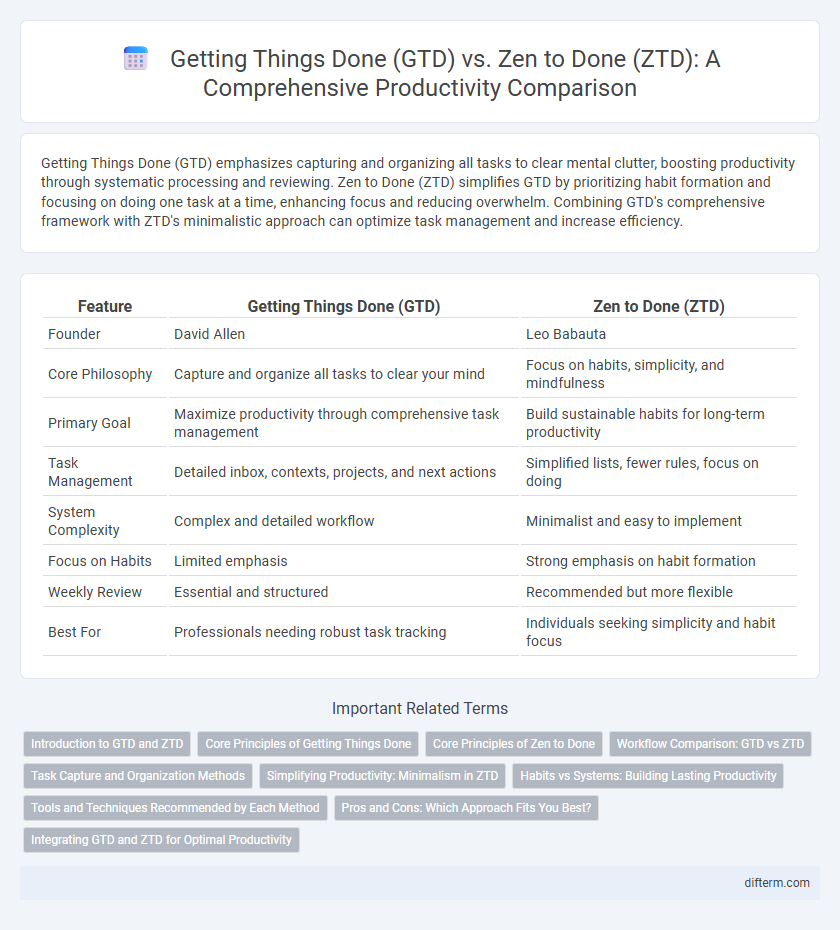Getting Things Done (GTD) emphasizes capturing and organizing all tasks to clear mental clutter, boosting productivity through systematic processing and reviewing. Zen to Done (ZTD) simplifies GTD by prioritizing habit formation and focusing on doing one task at a time, enhancing focus and reducing overwhelm. Combining GTD's comprehensive framework with ZTD's minimalistic approach can optimize task management and increase efficiency.
Table of Comparison
| Feature | Getting Things Done (GTD) | Zen to Done (ZTD) |
|---|---|---|
| Founder | David Allen | Leo Babauta |
| Core Philosophy | Capture and organize all tasks to clear your mind | Focus on habits, simplicity, and mindfulness |
| Primary Goal | Maximize productivity through comprehensive task management | Build sustainable habits for long-term productivity |
| Task Management | Detailed inbox, contexts, projects, and next actions | Simplified lists, fewer rules, focus on doing |
| System Complexity | Complex and detailed workflow | Minimalist and easy to implement |
| Focus on Habits | Limited emphasis | Strong emphasis on habit formation |
| Weekly Review | Essential and structured | Recommended but more flexible |
| Best For | Professionals needing robust task tracking | Individuals seeking simplicity and habit focus |
Introduction to GTD and ZTD
Getting Things Done (GTD) is a productivity methodology developed by David Allen that emphasizes capturing tasks in a trusted system and processing them through defined stages such as clarifying, organizing, reflecting, and engaging to reduce mental clutter and increase workflow efficiency. Zen to Done (ZTD), created by Leo Babauta, adapts core GTD principles with a simplified approach, prioritizing habit formation, focus on essential tasks, and minimizing complexity to foster sustainable productivity. Both systems aim to enhance time management and task completion but differ in structure and execution to cater to diverse productivity preferences.
Core Principles of Getting Things Done
Getting Things Done (GTD) centers on capturing all tasks and ideas into a reliable system, clarifying next actions, and regularly reviewing commitments to maintain focus and control. The methodology emphasizes breaking down projects into actionable steps and organizing tasks by context, priority, and time availability. Core principles such as workflow management, inbox zero, and weekly reviews enhance productivity by reducing mental clutter and ensuring consistent progress.
Core Principles of Zen to Done
Zen to Done (ZTD) centers on simplicity, focusing on forming one habit at a time to improve productivity, contrasting with the comprehensive, step-driven methodology of Getting Things Done (GTD). ZTD emphasizes clarity by capturing, processing tasks immediately, and simplifying task lists to prioritize critical actions, fostering consistent focus and reducing overwhelm. Its core principles promote habits such as daily planning, simplified organization, and focused work to create sustainable productivity improvements aligned with personal effectiveness.
Workflow Comparison: GTD vs ZTD
Getting Things Done (GTD) emphasizes a comprehensive five-step workflow: capture, clarify, organize, reflect, and engage, aimed at managing tasks through detailed categorization and regular reviews. Zen to Done (ZTD) simplifies this process by focusing on ten essential habits, prioritizing action and minimalism to reduce overwhelm and improve focus. ZTD streamlines workflow by combining GTD's foundational elements with a stronger emphasis on habit formation and simplicity for increased productivity.
Task Capture and Organization Methods
Getting Things Done (GTD) emphasizes capturing all tasks and commitments in a trusted system to clear mental clutter and enhance focus, using detailed lists and contexts for organization. Zen to Done (ZTD) simplifies this approach by focusing on capturing tasks in a minimalist manner and organizing them through prioritized lists and routines to reduce complexity. Both methods prioritize effective task capture but differ in structure, with GTD relying on extensive categorization and ZTD on streamlined habit formation.
Simplifying Productivity: Minimalism in ZTD
Zen to Done (ZTD) streamlines productivity by emphasizing minimalism, reducing GTD's complexity through focus on fewer core habits. Its simplified approach prioritizes essential tasks and habit formation, cutting through the overwhelming organization layers common in Getting Things Done (GTD). This minimalistic strategy enables sustainable productivity improvements by encouraging consistency and clarity rather than exhaustive task management.
Habits vs Systems: Building Lasting Productivity
Getting Things Done (GTD) emphasizes creating detailed workflows and systematic task management to organize work efficiently, while Zen to Done (ZTD) prioritizes cultivating core habits that simplify productivity and foster focus. GTD relies on comprehensive lists and context-based actions, whereas ZTD encourages habit formation like daily planning and minimizing distractions to sustain momentum. Building lasting productivity involves integrating ZTD's habit-driven approach with GTD's structured systems to create a balanced, adaptable workflow.
Tools and Techniques Recommended by Each Method
Getting Things Done (GTD) emphasizes comprehensive capture tools like inboxes, lists, and contexts to organize tasks, utilizing techniques such as the two-minute rule and weekly reviews to maintain workflow clarity. Zen to Done (ZTD) simplifies GTD by advocating a focus on fewer habits, prioritizing to-do lists, and implementing time-blocking alongside habit stacking to improve task completion and reduce overwhelm. Both methods recommend digital or physical tools that suit personal preferences, but ZTD leans more towards minimalism and daily focus, while GTD provides a broad, systematic approach.
Pros and Cons: Which Approach Fits You Best?
Getting Things Done (GTD) offers a comprehensive framework emphasizing clear task categorization and context-based organization, ideal for users managing complex workloads; however, its detailed setup can overwhelm beginners. Zen to Done (ZTD) simplifies GTD by focusing on habit formation and minimalism, fostering consistency but potentially sacrificing some organizational rigor. Choosing between GTD and ZTD depends on whether you prioritize thorough structure or streamlined, sustainable productivity habits.
Integrating GTD and ZTD for Optimal Productivity
Integrating Getting Things Done (GTD) and Zen to Done (ZTD) enhances productivity by combining GTD's structured task management with ZTD's emphasis on simplicity and habit formation. Applying GTD's workflow steps alongside ZTD's focus on prioritization and consistent routines streamlines decision-making and reduces overwhelm. This hybrid approach supports sustained focus, effective task completion, and long-term productivity improvements.
Getting Things Done (GTD) vs Zen to Done (ZTD) Infographic

 difterm.com
difterm.com